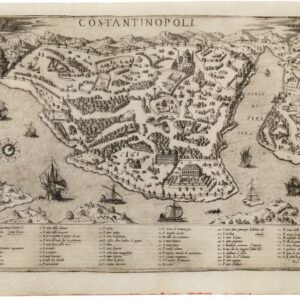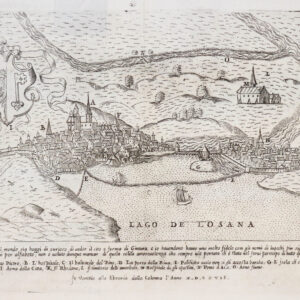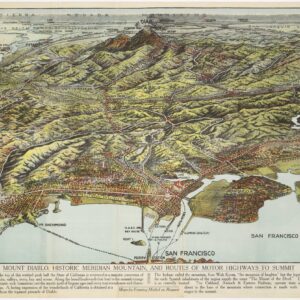Sébron’s scarce and highly dramatic view of the Horseshoe Arch of Niagara Falls.
Les Chutes du Niagara. Fer a Cheval / Niagara Falls. The Horseshoe.
$2,000
In stock
Description
This gorgeous hand-colored aquatint provides a spectacular view of Niagara Falls’ full horseshoe or Canadian Falls. It was produced in 1852 based on an oil painting made by the traveling French painter Hippolyte Victor Valentin Sébron, who visited the falls in 1850 and made two wonderful oil paintings during his stay. Sébron soon realized how enticing his dramatic depictions were and had the views engraved for commercial reproduction by Swiss graphic artist Friedrich Salathé. With the subsequent hand-coloring of the aquatint, this printed view emulated the vivacious realism of Sébron’s original painting.
In the mid-19th century, as today, Niagara Falls was a natural wonder that drew thousands of visitors each year. These early tourists are seen in the foreground of Sébron’s composition, but details in the landscape, like the watchtower and grand hotel in the distance, underscore the attraction further.
Sébron treats us to a view across the so-called horseshoe of the falls. In the foreground is a plateau from which various onlookers peer apprehensively into the roaring abyss below. The sheer force of the falls is made palpable by the throws of white foam and the strong winds tugging at hats and umbrellas near the rim. The strong winds may also be related to dark storm clouds and heavy rains that are rolling in from the south. On the plateau, an empty carriage is waiting to transport people back to their lodgings, and a guide is seemingly pointing out the approaching storm to some of his guests. The drama is further enhanced by a steamboat – the original Maid of the Mist – at the bottom of the falls. Despite sporting an open deck full of tourists, the vessel appears to be veering dangerously close to the raging plunge pool of the falls.
Sébron’s original paintings of Niagara Falls were well-received in elite circles of New York and New Orleans. By converting them to aquatints, he made his dramatic capture available to everyone. The attractive hand-colored prints quickly became – and remain – some of the most evocative and desirable depictions of Niagara Falls on the market.
Census
Sébron painted two canvasses when he visited Niagara Falls in 1850: a general view and this dedicated view of the horseshoe plunge. Both were engraved by Salathé for printing as aquatints. The rights to produce these were sold to Goupil & Co, a French lithography company that issued the views from their New York offices, hence the title in both French and English.
Despite its popularity at the time, the view is increasingly difficult to find. Only a single holding is listed by the OCLC, which is the Library of Congress (no. 957535430).
Cartographer(s):
Friedrich Salathé (17931858) was a Swiss engraver and graphic artist best known for his landscapes. Born in Binningen near Basel, Salathé apprenticed with Swiss painter Peter Birmann and later served on the Pope’s Swiss Guard. He returned to Binningen in 1821 before moving to Paris in 1823, where he achieved considerable success and recognition (including exhibited works at the Paris Salon in 1841).
Hippolyte Victor Valentin SébronHippolyte Victor Valentin Sébron (1801-1879) was a French painter who traveled and worked throughout Europe, Asia, and the United States. Born in the Seine-Maritime, Sébron is best known for his landscapes and dioramas, although other he painted other scenes as well. His work was regularly exhibited in Paris salons, at the London Royal Bazaar, and at the New York National Academy of Design.
In addition to his landscapes from across the world, Sébron worked closely with the inventor of the daguerreotype to create artworks that used lighting and painting techniques to create optical effects.
Condition Description
Average. View exhibits some surface abrasions, cracking, and tears. The view has been stabilized, and part of the lower margin has been reinstated by a professional art restorer. Laid down on linen.
References



